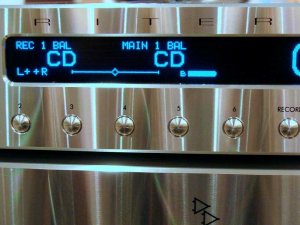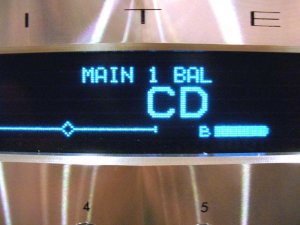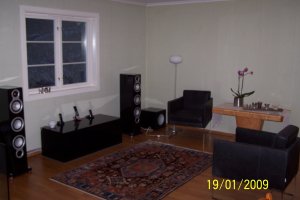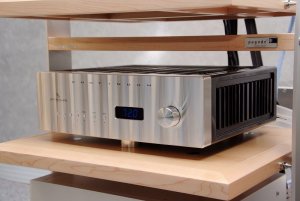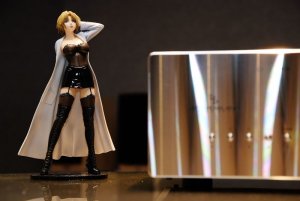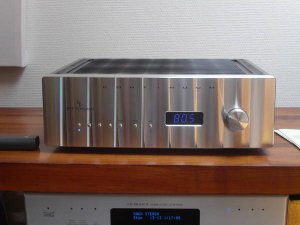Jeff Rowland
- Trådstarter HCS
- Startdato
Diskusjonstråd Se tråd i gallerivisning
-
Med det treverket, ja. Ville nok foretrekke den i et roligere mer diskret tre...slik jeg har sett den tidligere....eller helst bare sort.Valentino skrev:Sexy på den vulgære måten, ja.ENDELIG
Nå kan jeg igjen tre inn i det gode selskap. Lillebror Model 201 ankom i dag og er koblet opp for sjekk. Virker gjør de; til de grader. Kalde og harde, men dette lover veldig godt.
Jeg hadde egentlig planlagt kjøp av disse for mange år siden. Hadde da Synergy 2i, men av diverse årsaker endte jeg da opp med en Model 2. Disse ble igjen solgt da jeg flyttet og begyndte i ny jobb. Noe jeg angrer bittert på...
Planen med 201 er å koble til en Wadia cd-spiller og bruke Cardas kabler. Høyttalere er jeg ikke sikker på; ser litt på Dynaudio, både Contour og Confidence stativhøyttalere er aktuelle. Merlin VSM er også aktuell dersom jeg finner en brukt til fin pris. Årsaken til at Dynaudio og Merlin er på kortlisten er deres fantastiske elementer. Jeg eide tidligere Sonus faber Guarneri med diskant fra Dynaudio. Den diskanten vil jeg gjerne ha igjen! Har dere andre gode forslag?
Rommet de vil spille i er ca 40 m2 og de vil spille på ene kortveggen. Det vil bli nærfeltslytting, derfor ser jeg på toveis- og gjerne stativhøyttalere.
OPPDATERING:
Jeg ønsker IKKE gode råd siden jeg har kjøpt et sett Merlin MX. Vil helst ikke høre om andre bedre kombinasjoner ;D
Kan Concerto integrert benytte PC-1?HKviking skrev:Jeg har sjekket ut at man kan bruke to stk 501 med en PC-1 uten problemer. Kun bruke en fordeler (uten filter etc.) Concerto Pre-amp kan IKKE bruke PC-1!!!
(Mulig det kommer frem et sted i tråden, men jeg finner det ikke.)Hhobby
Gjest
Etter hva jeg har hørt skal det gå fint, men for Concerto må man visstnok bytte sikring samt endre en svitsj internt i ampen, i hvert fall for 110v utgaven. Om det er nødvendig for 230v utgaven vet jeg ikke. Hør med forhandler angående dette.Kim skrev:
Kan Concerto integrert benytte PC-1?HKviking skrev:Jeg har sjekket ut at man kan bruke to stk 501 med en PC-1 uten problemer. Kun bruke en fordeler (uten filter etc.) Concerto Pre-amp kan IKKE bruke PC-1!!!
(Mulig det kommer frem et sted i tråden, men jeg finner det ikke.)Der er det; Sort på rødtVedlegg
-
99.1 KB Visninger: 1.196
Interressant at de bruker ekstra lytter til 500ASP. LydMekk her inne gjorde en liknende modifikasjon av ICEpower1000ASP mener jeg å huske.wizard skrev:Innsiden av Continuum 250Nærbilder av Criterion
Main meny valg
BALANCE
START CHARGING
STOP CHARGING
RUN ON BATTERY
RUN ON AC
PHASE NORMAL
INVERT BOTH
INVERT LEFT
INVERT RIGHT
INPUT OFFSET
MAIN B UNBAL OUT
RECORD LEVEL
NAME-BLURAY
NAME-CD
NAME-DVD
NAME-DVDREC
NAME-DVR
NAME-PHONO
NAME-TAPE
NAME-VCRVedlegg
-
57.7 KB Visninger: 701
-
58.6 KB Visninger: 692
-
56.4 KB Visninger: 704
-
58.4 KB Visninger: 651
...og da er det bare å komme med bilder. Graulerer med supert forsterkeri!M1 skrev:Hei, da er jeg blitt eier av 2 stk 201 (brukte) og de er både kraftfulle og super oppløste.
;D
Mvh
M1Takk for det
Bilder ja, skal se etter i kamera om det er noen bilder etter en liten forforsterker test jeg gjorde på lørdag. Litt rotete pga testen, vanligvis er alt skjult.
Trenger anbefaling på forforsterker til 201. Har testet Electrocompaniet (gml EC-4) som virker bra og Vincent SA-31 som faktisk også er bra, men skal prøve Hegel og JR.
Mvh
M1Vedlegg
-
490.6 KB Visninger: 799
Og slik pleier det å se ut.Vedlegg
-
342.8 KB Visninger: 792
Jeg hadde i en periode Synergy 2i. Det er en killer! Kjørte den sammen med Chapter Audio TWO og senere Model 2 fra JRDG. Den passet godt til begge. Jeg kan ikke i dag skjønne hvorfor jeg solgte den ??? De går for rundt 25k, det er de verdt! Når det er sagt så mener jeg Concerto intigrert, som jeg bruker nå, spiller bedre enn Synergy 2i og Model 2. Men det er nok effektforsterkeren som må ta skylden for.Mute skrev:Erfaringer med pre-amper fra JR?Continuum ;DVedlegg
-
243 KB Visninger: 522
-
299.6 KB Visninger: 1.168
-
64.9 KB Visninger: 534
-
53.8 KB Visninger: 471
- Ble medlem
- 24.12.2005
- Innlegg
- 128
- Antall liker
- 3
Har en Synergy II i og er kjjempe fornøyd den er helt rå.Mute skrev:Erfaringer med pre-amper fra JR?
Har prøvd mange pre amper men det er ingen som har vært i nærheten a den i mitt oppsett.ER der noe her i forum som har noe erfaringer med Jeff Rowland Continuum 500? Jeg har en Concerto int. idag som jeg er meget fornøyed med, men ser en mulighet for å få noe eventuelt bedre.Hhobby
Gjest
Ja, jeg har Continuum 500. Har skrevet litt om den lenger tilbake i denne tråden om du søker. Uansett, en forrykende god forsterker, og som jeg holder for å være en prisvinner. Driver mine Virgo V med glans og får det hele til å låte uanstrengt, dynamisk, presist og samtidig veldig lettflytende og musikalsk.
PS: Har ikke hørt Concerto som du har.Noe ide om hva (vill)vejledende pris er i N? Den er ikke på prislisten til Lyric.Hhobby
Gjest
Tror du kan ta utgangspunkt i pris i USA = $8800 x valutakurs x 1,25Her er den siste prislisten fra den tyske importøren Taurus.
http://www.taurus-high-end.de/infomaterial/jeffrowland/preise/preisliste_jeffrowland_vk_0409.pdfTakker for div. svar. Har nå kjøpt en Continuum 500 med RIAA. Får den i løpet av neste uke. Kan nesten ikke vente!! her er den..Vedlegg
-
38.3 KB Visninger: 877
Jeg hadde gleden av å lytte til Contiuum 500 sist helg. Selv så har jeg en Concerto med PC-1 powersupply. Skal man samenligne disse så er dette den beste måten å gjøre det på. Uten PC-1 så spiller OK men ikke supert. Det er natt og dag i forskjell. Siden Contiuum 500 har PC-1 innebygget så blir dette det nærmeste av sammenligninsg grunnlag. Contiuum 250 er mer eller mindre samme som Concerto siden den ikke har noen PC-1 innebygget.
For tiden så er Contiuum 500 bestselger i Hong Kong innen integrerte forsterkere. Spiller det bra? Sure!!! Det spiller meget bra. En god del bedre enn Concerto med PC-1. Mere oppløst med enda bedre holografi.
Husker jeg riktig så koster Contiuum 500 ca. HKD 75.000. Criterion mener jeg kostet ca. HKD 184.000.Jeg satt lenge å vurderte om jeg skulle kjøpe PC-1 til min Concerto, men da jeg også ønsket RIAA/phono valgte jeg like godt å gå for et step op og få alt i en pakke. . Concertoen ble solgt på få timer, så den saken var også enkelt.Hei
Noen som har veil priser på pre ampene til JR? Criterion, Capri og Concerto......
Hvordan er lyden i disse? Nøytralt? Lyst? Varmt?
Hvilke høyttalere anbefales det å bruke JR pre til? Jeg har ett par JBL høyttalere, kan det være en god match? Jeg vil bytte Hegel preen min i noe "varmere". Vurderer sterkt en rør pre, men JR kan være en kandidat. Jeg har også hørt at Respons spiller bra med JR pre amper? Noen som har hørt den kombinasjonen?
Ønsker litt info, generelt rundt pre ampene til JR
Jeg har ikke lyttet til Pre-ampen til Concerto alene. JR produktene spiller meget bra på Marten, Avalon & Dynaudio. De har jeg lyttet på allerede. Veldig detaljert og raskt. Super kontrollert og ikke så typisk Amerikansk lyd som noen velger å kalle det.KentOve skrev:Hei
Noen som har veil priser på pre ampene til JR? Criterion, Capri og Concerto......
Hvordan er lyden i disse? Nøytralt? Lyst? Varmt?
Hvilke høyttalere anbefales det å bruke JR pre til? Jeg har ett par JBL høyttalere, kan det være en god match? Jeg vil bytte Hegel preen min i noe "varmere". Vurderer sterkt en rør pre, men JR kan være en kandidat. Jeg har også hørt at Respons spiller bra med JR pre amper? Noen som har hørt den kombinasjonen?
Ønsker litt info, generelt rundt pre ampene til JRHhobby
Gjest
May 9th, 2009 -- by Guido Corona
Source: The Absolute Sound
Comfortable with the warm heft of my 20-year old JRDG Model 7M monoblocks, and somewhat familiar with the clean but admittedly polite sound of the original Jeff Rowland 302, I was totally unprepared to fall in love with the robust yet agile grace of Rowlands newest stereo amplifier flagshipthe 312. Authoritative rather than merely precise, harmonically textured rather than simply detailed, filigreed in the treble rather than merely extended, the 312 controlled my Vienna Mahlers like an iron fist in a velvet glove.
Weighing a hefty 83 pounds, the 312 is hardly a minimalist device. According to Jeff Rowland, it combines the third-generation ASP 1000 ICEpower conversion modules at its core with custom-engineered input and output circuits, as fundamental building blocks of a sophisticated instrument-grade amplifier. While the original 302 exploited second-generation ICE modules capable of a respectable 360W into 8 ohms, the twin third-generation ASP 1000 modules of the 312 deliver 500W into 8 ohms and 1000W into 4 ohms.
Yet, JRDG has shaved almost 20 pounds off the 312 by adopting a new dual mono design. The single massive transformer and custom switching power supplies of the 302 have been replaced by twin 700W PFC units feeding much lighter dual power transformers that control switching power supplies integrated into the ICEpower modules. The internal operating voltage in the output stages has been raised from 84V to 125V DC, and furnishes a peak current of 45A of balanced power to the 312s patented Cardas output binding posts. New circuitry prevents damage to the amplifier caused by occasional shorting of speaker wires.
According to JRDG, Power Factor Correction (PFC) is the key to the 312s musicality. PFC taps energy out of an inductor circuit during the entire AC cycle100,000 times per second through a high-speed switch. By using energy out of the wall outlet to charge the 312s power-supply capacitors during most of the AC cycle, it lets the 312 achieve an astonishing power conversion efficiency of almost 98%. PFC also minimizes distortions caused by 120Hz peak surge currents during capacitor charge, and subsequent deleterious back pulses into the AC mains grid.
Jeff Rowland suggests that break-in of ICEpower modules, input transformers, and other electronic components may take a particularly long time. Even after several months, some residual magnetization and electric fields may slowly build up during long overnight idle time, only to ebb gradually once more to a vanishing point during playback. Thus, while the 312 may be kept always operational thanks to its extreme efficiency, audible parameters like its impressive bass control and musicality, its delicate texturing of harmonics and treble, and its remarkably effortless authority are not necessarily realized instantaneously after a full night of idling; yet, in just a couple of hours of playing music, they gradually blossom once more into characteristic magnificence.
http://www.avguide.com/review/first-look-jeff-rowland-design-312-power-amplifierEr disse nye JF multivoltage eller?? PÅ min nye Continium 500 står det VAC 210-250. På kassen står det 110V!
Ja! det derfor at jeg lurer på hvorfor den er merket med 210-265!HKviking skrev:Continuum 500 er innebygget med PC-1 da skal det være 85v - 265v. -
-
Laster inn…
Diskusjonstråd Se tråd i gallerivisning
-
-
Laster inn…




















